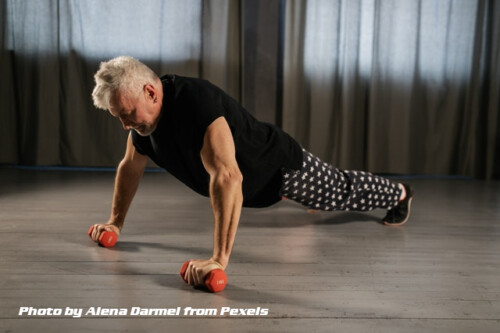Four Types of Exercise Can Improve Your Health and Physical Ability
Most people tend to focus on one type of exercise or activity and think they’re doing enough. Research has shown that it’s important to get all four types of exercise: endurance, strength, balance, and flexibility. Each one has different benefits. Doing one kind also can improve your ability to do the others, and variety helps reduce boredom and risk of injury. No matter your age, you can find activities that meet your fitness level and needs!
On this page:
Endurance Exercises for Older Adults
Endurance activities, often referred to as aerobic, increase your breathing and heart rates. These activities help keep you healthy, improve your fitness, and help you perform the tasks you need to do every day. Endurance exercises improve the health of your heart, lungs, and circulatory system. They also can delay or prevent many diseases that are common in older adults such as diabetes, colon and breast cancers, heart disease, and others. Physical activities that build endurance include:
- Brisk walking or jogging
- Yard work (mowing, raking)
- Dancing
- Swimming
- Biking
- Climbing stairs or hills
- Playing tennis or basketball
Increase your endurance or “staying power” to help keep up with your grandchildren during a trip to the park, dance to your favorite songs at a family wedding, and rake the yard and bag up leaves. Build up to at least 150 minutes of activity a week that makes you breathe hard. Try to be active throughout your day to reach this goal and avoid sitting for long periods of time.
Safety Tips
- Do a little light activity, such as easy walking, before and after your endurance activities to warm up and cool down.
- Listen to your body: endurance activities should not cause dizziness, chest pain or pressure, or a feeling like heartburn.
- Be sure to drink liquids when doing any activity that makes you sweat. If your doctor has told you to limit your fluids, be sure to check before increasing the amount of fluid you drink while exercising.
- If you are going to be exercising outdoors, be aware of your surroundings.
- Dress in layers so you can add or remove clothes as needed for hot and cold weather.
- To prevent injuries, use safety equipment, such as a helmet when bicycling.
Strength Exercises for Older Adults
Your muscular strength can make a big difference. Strong muscles help you stay independent and make everyday activities feel easier, like getting up from a chair, climbing stairs, and carrying groceries. Keeping your muscles strong can help with your balance and prevent falls and fall-related injuries. You are less likely to fall when your leg and hip muscles are strong. Some people call using weight to improve your muscle strength “strength training” or “resistance training.”
Some people choose to use weights to help improve their strength. If you do, start by using light weights at first, then gradually add more. Other people use resistance bands, stretchy elastic bands that come in varying strengths. If you are a beginner, try exercising without the band or use a light band until you are comfortable. Add a band or move on to a stronger band (or more weight) when you can do two sets of 10 to 15 repetitions easily. Try to do strength exercises for all of your major muscle groups at least 2 days per week, but don’t exercise the same muscle group on any 2 days in a row. Below are a few examples of strength exercises:
- Lifting weights
- Carrying groceries
- Gripping a tennis ball
- Overhead arm curl
- Arm curls
- Wall push-ups
- Lifting your body weight
- Using a resistance band
Safety Tips
- Don’t hold your breath during strength exercises and breathe regularly.
- Breathe out as you lift or push, and breathe in as you relax.
- Talk with your doctor if you are unsure about doing a particular exercise.
Balance Exercises for Older Adults
Balance exercises help prevent falls, a common problem in older adults that can have serious consequences. Many lower-body strength exercises also will improve your balance. Balance exercises include:
- Tai Chi, a “moving meditation” that involves shifting the body slowly, gently, and precisely, while breathing deeply.
- Standing on one foot.
- The heel-to-toe walk.
- The balance walk.
- Standing from a seated position.
Safety Tips
- Have a sturdy chair or a person nearby to hold on to if you feel unsteady.
- Talk with your doctor if you are unsure about a particular exercise.
Flexibility Exercises for Older Adults
Stretching can improve your flexibility. Moving more freely will make it easier for you to reach down to tie your shoes or look over your shoulder when you back your car out of the driveway. Flexibility exercises include:
Safety Tips
- Stretch when your muscles are warmed up.
- Stretch after endurance or strength exercises.
- Don’t stretch so far that it hurts.
- Always remember to breathe normally while holding a stretch.
- Talk with your doctor if you are unsure about a particular exercise.
For More Information About Exercise and Physical Activity
American Council on Exercise
888-825-3636 (toll-free)
[email protected]
www.acefitness.org
American Physical Therapy Association
800-999-2782 (toll-free)
consumer@community-adminorg
www.moveforwardpt.com
Centers for Disease Control and Prevention (CDC)
800-232-4636 (toll-free)
888-232-6348 (TTY/toll-free)
[email protected]
www.cdc.gov
Office of Disease Prevention and Health Promotion (ODPHP)
240-453-8280
[email protected]
https://health.gov/
MedlinePlus
National Library of Medicine
www.medlineplus.gov
National Council on Aging
571-527-3900
https://www.ncoa.org/
This content is provided by the NIH National Institute on Aging (NIA). NIA scientists and other experts review this content to ensure it is accurate and up to date.
Content reviewed: January 29, 2021

